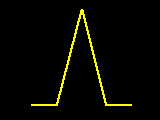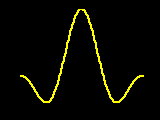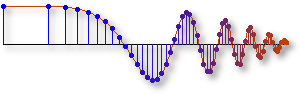D/A conversion requires interpolation to reconstruct the analog
signal from its digital samples.
This reconstruction process can be expressed as a linear
combination of shifted pulses.
The pulse shape will affect the quality of the reconstruction, as
will the relative sampling rate.
When the signal is oversampled, interpolation is much easier and
the reconstructed analog signal closely matches its original form.
The nine movies below illustrate the varying quality of the
reconstruction with different pulse shapes and different sampling
rates.
 |
Three movies that illustrate reconstruction at various sampling rates via the square pulse: at one, two and four times the Nyquist rate. |
 |
Three movies that illustrate reconstruction at various sampling rates via the triangular pulse: at one, two and four times the Nyquist rate. |
 |
Three movies that illustrate reconstruction at various sampling rates via the truncated ideal pulse: at one, two and four times the Nyquist rate. |
